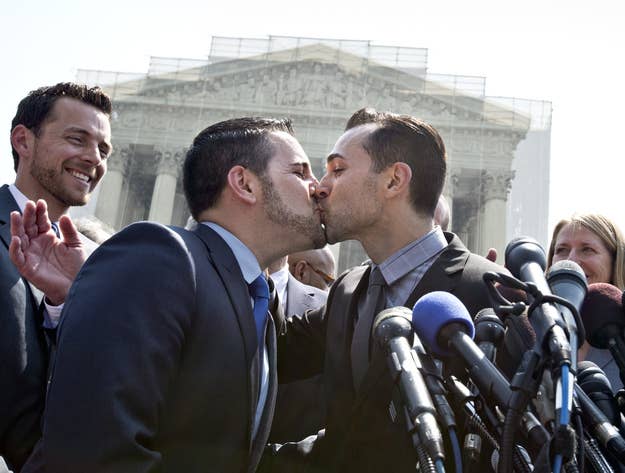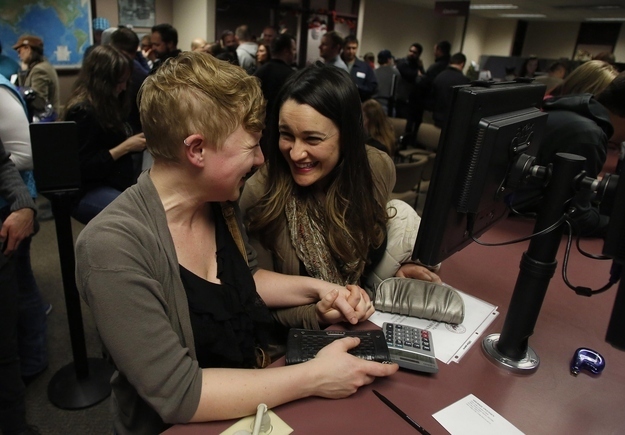
WASHINGTON — Two times as many states have marriage equality now, as 2013 comes to a close, than did when the year began.
Nowhere was the impact of that change more clear than when U.S. District Court Judge Robert Shelby issued his decision from Utah on Dec. 20 declaring the state's 2004 amendment banning same-sex couples from marrying unconstitutional.
"The Fourteenth Amendment protects the liberty rights of all citizens, and none of the State's arguments presents a compelling reason why the scope of that right should be greater for heterosexual individuals than it is for gay and lesbian individuals," he wrote. "If ... a heterosexual person's choices about intimate association and family life are protected from unreasonable government interference in the marital context, then a gay or lesbian person also enjoys these same protections."
With Utah's same-sex couples marrying over the past two weeks, 18 states, plus the District of Columbia, have marriage equality as the law of the state. Shelby's decision is on appeal, but — unless the Supreme Court steps in — same-sex couples are marrying there for now. New Mexico's Supreme Court unanimously decided the day before Shelby issued his ruling that marriage equality was required under that state's constitution.
Those two states were only the latest in a year of breakneck progress on the marriage equality front — even as workplace protections for LGBT workers remain stalled in Congress and, in a more narrow format, at the White House. Other issues — from the upcoming Winter Olympics in Sochi, Russia, to the treatment of international LGBT rights more broadly — also garnered attention throughout the year, but the result of that focus has been a mixed bag.
But, for marriage equality advocates, it was an incredible year. Coming off the unprecedented 2012 success at the polls for marriage in Maine, Maryland, and Washington, politicians began moving. Delaware, Minnesota, and Rhode Island's lawmakers passed and their governors signed legislation creating marriage equality in their states in May — as the Supreme Court was considering what to do with the Defense of Marriage Act and California's Proposition 8 marriage amendment.
On June 26, the Supreme Court struck down Section 3 of DOMA, which banned the federal government from recognizing same-sex couples' marriages and dismissed an appeal over Proposition 8, leading to the end of the ban on marriage equality in California.
"For same-sex couples who wished to be married, the State acted to give their lawful conduct a lawful status," Justice Anthony Kennedy wrote for the court in the DOMA case brought by Edith Windsor, whose wife, Thea Spyer, died in 2009. "DOMA seeks to injure the very class New York seeks to protect. By doing so it violates basic due process and equal protection principles applicable to the Federal Government."

After a summer and fall of progress in terms of the federal government expanding benefits to same-sex couples in the wake of the DOMA ruling, a judge in New Jersey ruled that, in light of the expansion in federal rights, New Jersey's civil unions were no longer sufficient at providing same-sex couples with the same rights that opposite-sex couples in New Jersey received. After the state Supreme Court refused to stop the trial judge's ruling from going into effect, suggesting it likely would agree with that judge, Gov. Chris Christie ended his appeal and marriage equality came to the Garden State.
Then, lawmakers in Hawaii and Illinois passed marriage equality bills that were ceremoniously signed by their governors before the December rulings in New Mexico and Utah. A federal judge in Ohio, in a more narrow ruling, found that Ohio had to recognize the out-of-state marriages of same-sex couples, although the couples only sought that recognition for the limited purpose of being listed as married on death certificates.
The progress is rapid, and more is likely to come early in 2014, with cases percolating up to the federal appeals courts across the country. A Nevada marriage challenge already is before the 9th Circuit, the Utah case is before the 10th Circuit, and Ohio officials have said they will be appealing the case there to the 6th Circuit. There are also two cases before federal judges in Virginia, either or both of which likely will end up before the 4th Circuit Court in 2014.
A federal trial is slated for February in Michigan over that state's marriage amendment, any appeal of which would go to the 6th Circuit. There are cases in Pennsylvania, West Virginia, and several other states that will be progressing in the other states without marriage equality, with more likely to be filed as 2014 progresses.
Then, there is an expected ballot initiative in Oregon, where voters will be asked to overturn the amendment passed in 2004 banning same-sex couples from marrying. A group in Ohio that does not currently have support from national LGBT organizations also is pushing for a 2014 ballot measure there to overturn the 2004 amendment that bans recognition of same-sex couples' marriages and similar legal statuses.
There is no question that a country with 18 states that have granted same-sex couples marriage licenses is dramatically different than one in which nine states had done so. It also is notable how the change is happening.

At this time, lawmakers in 13 of the 18 states with marriage equality at one point or another voted in favor of marriage equality. Judges appointed by presidents from as far back as Richard Nixon to as recently as Barack Obama have found bans on recognition of same-sex couples' marriages, whether at the state or federal level, to be unconstitutional. And, as U.S. District Court Timothy Black wrote in the Ohio case this past week, it's becoming the default American position.
"[T]he lower courts are applying the Supreme Court's decision, as they must, and the question is presented whether a state can do what the federal government cannot — i.e., discriminate against same-sex couples ... simply because the majority of the voters don't like homosexuality (or at least didn't in 2004)," he wrote. "Under the Constitution of the United States, the answer is no."
Although Black, like Shelby in Utah, won't have the final word on marriage, their voices are not outliers or even part of a sizable minority. They represent the mainstream judicial position in the federal courts over the past three years.
It is only a matter of time before the question returns to the Supreme Court, and 2013 will be seen as the year that the "tipping point" in public opinion on marriage equality, often discussed in recent years, turned into government action all over — from President Obama and the federal government to governors and from lawmakers to judges.
There will, doubtless, be other difficult steps for advocates like Evan Wolfson, Andrew Sullivan, Mary Bonauto, and others who have been pressing the case for marriage equality for decades. It became clear in 2013, though, that these advocates — once dismissed as pitching impossible dreams — would be proven right more quickly than almost anyone could have predicted.
Looking back on this year's incredible movement, 2013 will be known as the year that began the march to the end of the marriage equality project.
